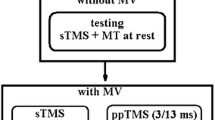Abstract
We used transcranial magnetic stimulation to study the modulation of motor cortex excitability after rapid repetitive movements. Eleven healthy subjects aged 24–32 years were evaluated. Serial motor-evoked potential (MEP) recordings were performed from the right thenar eminence every 5 min for a period of 20 min at rest and for a period of 35 min after repetitive abduction-adduction of the thumb at maximal frequency for 1 min. All subjects presented distinct changes in MEP amplitude after exercise with an approximately 55% mean maximal decrease compared with basal conditions and complete recovery 35 min after the end of the exercise. The time course of MEP amplitude changes presented the following trend: (1) a rapid decrease phase within the first 5 min; (2) a maximal depression phase of 10 min duration (from the 5th to the 15th min); and (3) a slow recovery phase. No significant modifications in post-exercise MEP amplitude were found in ipsilateral non-exercised muscles. In order to determine the level where these changes take place, we recorded the M and F waves induced by median nerve stimulation at the wrist (all subjects) and MEPs in response to transcranial electrical stimulation (five subjects) at rest and during the decrease and maximal depression phases. None of these tests were significantly affected by exercise, indicating that the motor cortex was the site of change. Evaluation of maps of cortical outputs to the target muscle, performed in four subjects, showed an approximately 40% spatial reduction in stimulation sites evoking a motor response during the maximal depression phase. These data prove that exercise induces a reversible, long-standing depression of cortical excitability, probably related to intracortical presynaptic modulation, which transitorily reduces the motor representation area.
Similar content being viewed by others
References
Amassian VE, Stewart M, Quirk GJ, Rosenthal JL (1987) Physiological basis of motor effects of a transient stimulus to cerebral cortex. Neurosurgery 20:74–93
Brasil-Neto JP, Cohen LG, Pascual-Leone A, Jabir FK, Wall RT, Hallett M (1992) Rapid reversible modulation of human motor outputs after transient deafferentation of the forearm:a study with transcranial magnetic stimulation. Neurology 42:1302–1306
Brasil-Neto JP, Valls-Sole' J, Pascual-Leone A, Cammarota A, Amassian VE, Cracco R, Maccabee P, Cracco J, Hallett M, Cohen LG (1993a) Rapid modulation of human cortical motor outputs following ischaemic nerve block. Brain 116:511–525
Brasil-Neto JP, Leone AP, Valls-Sole' J, Cammarota A, Cohen LG, Hallett M (1993b) Postexercise depression of motor-evoked potentials: a measure of central nervous system fatigue. Exp Brain Res 93:181–184
Cohen LG, Brasil-Neto J, Pascual-Leone A, Wall RT, Jabir FK, Hallett M (1991a) Rapid reversible reorganization in maps of outputs of human motor cortex following transient restrictive deafferentation. Soc Neurosci Abstr l7:1112
Cohen LG, Bandinelli S, Findley TW, Hallett M (1991b) Motor reorganization after upper limb amputation in man. Brain 114:615–627
Day BL, Thompson PD, Dick JP, Nakashima K, Marsden CD (1987) Different sites of action of electrical and magnetic stimulation of the human brain. Neurosci Lett 75:101–106
Donoghue JP, Sanes JN (1988) Organization of adult motor cortex representation patterns following neonatal nerve injury in rats. J Neurosci 8:3221–3232
Donoghue JP, Suner S, Sanes JN (1990) Dynamic organization of primary motor cortex output to target muscles in adult rats. II. Rapid reorganization following motor nerve lesions. Exp Brain Res 79:492–503
Fischer MA (1992) AAEM Minomonograph 13: H reflexes and F waves: physiology and clinical indications. Muscle Nerve 15:1223–1233
Fuhr P, Cohen LG, Dang N, Findley T, Haghighi S, Oro J, Hallett M (1992) Physiological analysis of motor reorganization following lower limb amputation. Electroencephalogr Clin Neurophysiol 85:53–60
Jones EG (1993) GABAergic neurons and their role in cortical plasticity in primates. Cereb Cortex 3:361–372
Kiers L, Cros D, Chiappa KH, Fang J (1993) Variability of motor potentials evoked by transcranial magnetic stimulation. Electroencephalogr Clin Neurophysiol 89:415–423
Kimberle MJ, Donoghue JP (1991) Reshaping the cortical motor map by unmasking latent intracortical connections. Science 251:944–947
Milanov IG (1992) A comparison of methods to assess the excitability of lower motoneurones. Can J Neurol Sci 19:64–68
Mortifee P, Stewart H, Schulzer M, Eisen A (1994) Reliability of transcranial magnetic stimulation for mapping the human motor cortex. Electroencephalogr Clin Neurophysiol 93:131–137
Pascual-Leone A, Grafman J, Hallett M (1994) Modulation of cortical output maps during development of implicit and explict knowledge. Science 263:1287–1289
Rossini MP, Caramia M, Zarola F (1987) Central motor tract propagation in man: studies with non-invasive, unifocal, scalp stimulation. Brain Res 415:211–225
Rothwell JC, Thompson PD, Day BL, Boyd S, Marsden CD (1991) Stimulation of the human motor cortex through the scalp. Exp Physiol 76:159–200
Sanes JN, Suner S, Donoghue JP (1990) Dynamic organization of primary motor cortex output to target muscles in adult rats. I. Long-term patterns of reorganization following motor or mixed peripheral nerve lesions. Exp Brain Res 79:479–491
Sanes JN, Wang J, Donoghue JP (1992) Immediate and delayed changes of rat motor cortical output representation with new forelimb configurations. Cereb Cortex 2:141–152
Topka H, Cohen LG, Cole RC, Hallett M (1991) Reorganization of corticospinal pathways following spinal cord injury. Neurology 41:1276–1283
Wassermann EM, Mcshane LM, Hallett M, Cohen LG (1992) Noninvasive mapping of muscle representations in human motor cortex. Electroencephalogr Clin Neurophysiol 85:1–8
Author information
Authors and Affiliations
Rights and permissions
About this article
Cite this article
Zanette, G., Bonato, C., Polo, A. et al. Long-lasting depression of motor-evoked potentials to transcranial magnetic stimulation following exercise. Exp Brain Res 107, 80–86 (1995). https://doi.org/10.1007/BF00228019
Received:
Accepted:
Issue Date:
DOI: https://doi.org/10.1007/BF00228019




